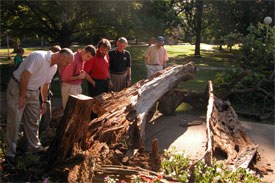Sassafras comes down after winds deal final blow
- September 27, 2005
- |
- Kevin Teets, Senior Reporter
- Section: News
It has inspired poetry and has been the unofficial logo of the university. It’s been rooted at UTM longer than anyone else and has spent its last years on the life support of steel cables.
But as the chainsaw ripped through its bark on Friday afternoon it was evident that even the sassafras tree in the middle of the quad could not escape mortality. The tree that has been the center of much attention for many years has now been reduced to a stump.
In an e-mail sent out to faculty, Chancellor Nick Dunagan said that the tree would be cut down because it had become a safety concern. “As many of you know, the sassafras tree took another hit during the Hurricane Katrina rain and wind. Upon the recommendation of several individuals and in consideration of the hazard that the leaning and dying tree has created, I have asked our grounds staff to remove our beloved sassafras tree.”
No one really knows how old the sassafras tree is. Dr. Philip Smart, assistant professor of natural resource management, says that it has become difficult to assess the tree’s age.
“You can’t determine a tree’s age by its size. If it’s growing in a good location then it would be big. There’s no way to have a reliable estimate of the tree’s age because it is hollow. Normally an increment core would be done to see the tree’s age,” Smart says.
Smart says that he would not be surprised if the tree is the oldest in Weakley County and that the tree is unique because unlike most sassafras trees that have three different shapes of leafs, this tree predominately has leafs that are referred to as single lobe. “There are no mitten-shaped leaves on this tree at all,” Smart says.
But, the tree is far from being a state record in its size. Smart says that the sassafras in the state that holds the state record for its size is found in Giles County. This tree has a diameter at breast height (DBA) of 59 inches. UTM’s sassafras tree is estimated at 24 inches in DBA, far from the state record.
Smart says the tree probably garnered a lot of attention because of its central location in the quad. Others have recognized the tree for its resilience. Former Chancellor Larry McGee (1971-1979) liked the tree so much that he incorporated a pen and ink drawing of it as the unofficial logo for the campus. The drawing was created by Professor Emeritus Bill Nelson.
In 1979 the tree sparked joking poetry writings between now IT Services Administrator Larry Holder and Chancellor McGee. Holder wrote, “There’s nothing greater I’d like to see than the cutting of the chancellor’s tree ... Just when I thought I was feeling better, I discovered it on the chancellor’s letter...”
Also joking, McGee wrote another poem to Holder. Some of it reads, “Oh Woodsman Holder, don’t axe my tree: Please help stamp out Sassafras tea! Who cuts my tree cuts me, and if you do, I will fall on you!”
Fortunately the tree came down without falling on anyone. It was cut down last Friday at 4 p.m. after Provost Tom Rakes delivered remarks. “As we change ourselves, this symbol of our own heritage is changing. We have individuals who are working to ensure this tree will live again to mirror our past while reflecting a new future,” Rakes said.
Dr. Smart says that the Ag Department is in the process of propagating the tree through a method called “cutting.” The first efforts at cutting the tree seem to be unsuccessful. “A couple of weeks ago we tried doing it (cutting) from the limbs. There’s no success shown with that,” Smart says. The department will now try taking cuttings from root samples and Smart says he is more optimistic of propagating the tree through this method.
Some will appreciates the tree’s history and some will always remember it as a simile of the campus’s dedication and longevity. Others will attempt to grow shoots from the tree. But at least for now, all will have an extra stump on which to sit if the benches in Centennial Circle become full.

Faculty members investigate the fallen sassafras tree in the center of the Quad Friday. The iconic tree, which was the oldest on campus, inspired poetry and sparked visitors’ curiosity for years. The tree, centrally located on the grassy Quad, was cut down because of high winds from the remnants of Hurricane Katrina.